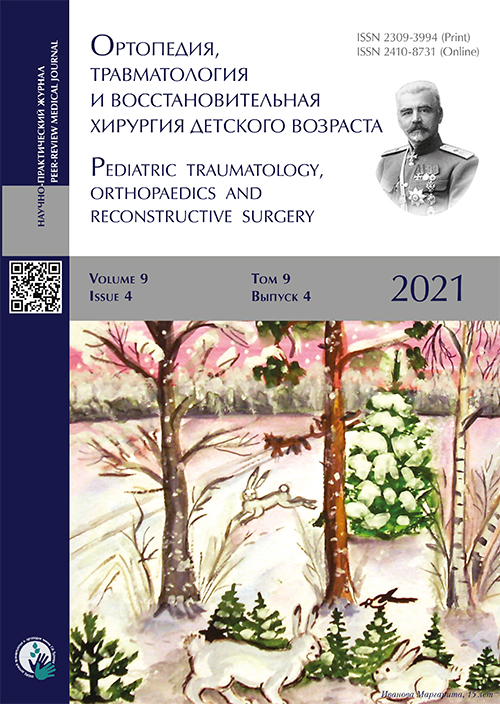Prosthetic liner-socket design for children with long congenital and amputated shoulder
- Authors: Kruglov A.V.1,2, Lein G.A.2
-
Affiliations:
- LLC North-West scientific-practical center of rehabilitation and prosthetics “Ortetika”
- LLC prosthetic and orthopedic center “Scoliologic.ru”
- Issue: Vol 9, No 4 (2021)
- Pages: 427-434
- Section: Original Study Article
- Submitted: 05.07.2021
- Accepted: 11.11.2021
- Published: 15.12.2021
- URL: https://journals.eco-vector.com/turner/article/view/75653
- DOI: https://doi.org/10.17816/PTORS75653
- ID: 75653
Cite item
Abstract
BACKGROUND: Traditional cosmetic prosthetic designs for a long shoulder stump in children have several disadvantages, such as a rigid uncomfortable receiving socket, the need to use a strap fastening, and the non-cosmetic product due to the disproportionate shoulder and forearm length compared with the preserved limb.
AIM: This study aimed to design, manufacture, and test a prototype of the shoulder stump liner-socket.
MATERIALS AND METHODS: A new liner-socket of a shoulder cosmetic prosthesis has been developed, confirmed by a Russian Federation patent for an invention, which for the first time, in the practice of domestic prosthetics, is made of two types of silicone and has been successfully used in cosmetic prosthetics for 17 children, of whom 10 previously used traditional long stump prosthesis. Satisfaction with new liner-socket prosthesis was analyzed using a psychometric scale compared with a conventional prosthesis.
RESULTS: The developed design combines both the inner socket function, which allows the elbow hinge to be attached to it and the liner properties, which ensures a comfortable stay of the stump in the receiving socket due to the properties of silicone and excludes the use of traditional bandages.
CONCLUSIONS: The presented medical and technical solution ensures the simplicity and reliability of fastening the cosmetic shoulder stump prosthesis, including on the long shoulder stump, without disturbing the relatively healthy limb proportions, as well as wearing comfort.
Full Text
About the authors
Anton V. Kruglov
LLC North-West scientific-practical center of rehabilitation and prosthetics “Ortetika”; LLC prosthetic and orthopedic center “Scoliologic.ru”
Email: kruglov@scoliologic.ru
ORCID iD: 0000-0002-3811-5773
SPIN-code: 3312-5350
https://www.instagram.com/kruglov_scoliologic/
MD, PhD, The Head of upper limb prosthetic department
Russian Federation, Saint Petersburg; Saint PetersburgGregory A. Lein
LLC prosthetic and orthopedic center “Scoliologic.ru”
Author for correspondence.
Email: lein@scoliologic.ru
ORCID iD: 0000-0001-7904-8688
MD, PhD
Russian Federation, Saint PetersburgReferences
- Rukovodstvo po protezirovaniyu i ortezirovaniyu. In 2 vol. Ed. by M.A. Dyimochka, A.I. Suhoverova, BG Spivak. 3rd ed. Moscow; 2016. (In Russ.)
- Reabilitaciya invalidov: nacional’noe rukovodstvo. Ed. by G.N. Ponomarenko. Moscow: GEOTAR-Media; 2018. (In Russ.)
- Reabilitaciya invalidov: nacional’noe rukovodstvo. Kratkoe izdanie. Ed. by G.N. Ponomarenko. Moscow: GEOTAR-Media; 2020. (In Russ.)
- Zamilackij YuI, SHCHerbina KK, Andrievskaya AO, et al. Konstrukcii protezov verhnih konechnostej: uchebnoe posobie. Ed. by G.N. Ponomarenko. Saint Peterburg: CIACAN; 2019. (In Russ.)
- Zamilackij YuI, SHCHerbina KK, Suslyaev VG, et al. Tekhnologiya izgotovleniya priemnyh gil’z protezov verhnih konechnostej: uchebno-prakticheskoe posobie. Ed. by G.N. Ponomarenko. Saint Peterburg: CIACAN; 2019. (In Russ.)
- Gil’za-lajner dlya kul’ti plecha: pat. 2721540 RF, MPK A61F2/54. A.V. Kruglov, G.A. Lein; patentoobladatel’: Skoliolodzhik.ru. No. 2019137451; zayavl. 21 Nov 2019; opubl. 19 May 2020. (In Russ.)
- Ponomarenko GN, Shcherbina KK, Golubeva YB, Galaudina VV. On the quality of prosthetic and orthopedic appliances. Standards and Quality. 2020;(2):94−99. (In Russ.)
- Smirnova LM, Shcherbina KK, Galaudina VV, Golubeva YB. A regulatory framework for the quality assessment of prosthetics. Standards and Quality. 2019;(6):46−51.
- Salminger S, Stino H, Pichler LH, et al. Current rates of prosthetic usage in upper-limb amputees- have innovations had an impact on device acceptance? Disabil Rehabil. 2020:1−12. doi: 10.1080/09638288.2020/1866684
- Brack R, Amalu EH. A review of technology, materials and R&D challenges of upper limb prosthesis for improved user suitability. J Orthop. 2020;23:88−96. doi: 10.1016/j.jor.2020.12.009
- Biddiss EA, Chau TT. Upper limb prosthesis use and abandonment: a survey of the last 25 years. Prosth Orthot Int. 2007;31(3):236−257. doi: 10.1080/03093640600994581
- Kyberd PJ, Hill W. Survey of upper limb prosthesis users in Sweden, the United Kingdom and Canada. Prosth Orthot Int. 2011;35(2):234−241. doi: 10.1177/0309364611409099
- Stephens-Fripp В, Walker MJ, Goddard E, et al. A survey on what Australians with upper limb difference want in a prosthesis: justification for using soft robotics and additive manufacturing for customized prosthetic hands. Disabil Rehabil Assist Technol. 2020;15(3):342−349. doi: 10.1080/17483107. 2019.1580777
- Sims T, Cranny A, Metcalf Ch, et al. Participatory design of pediatric upper limb prostheses: qualitative methods and prototyping. Int J Technol Assess Health Care. 2017;33(6):629−637. doi: 10.1017/S0266462317000836
Supplementary files












